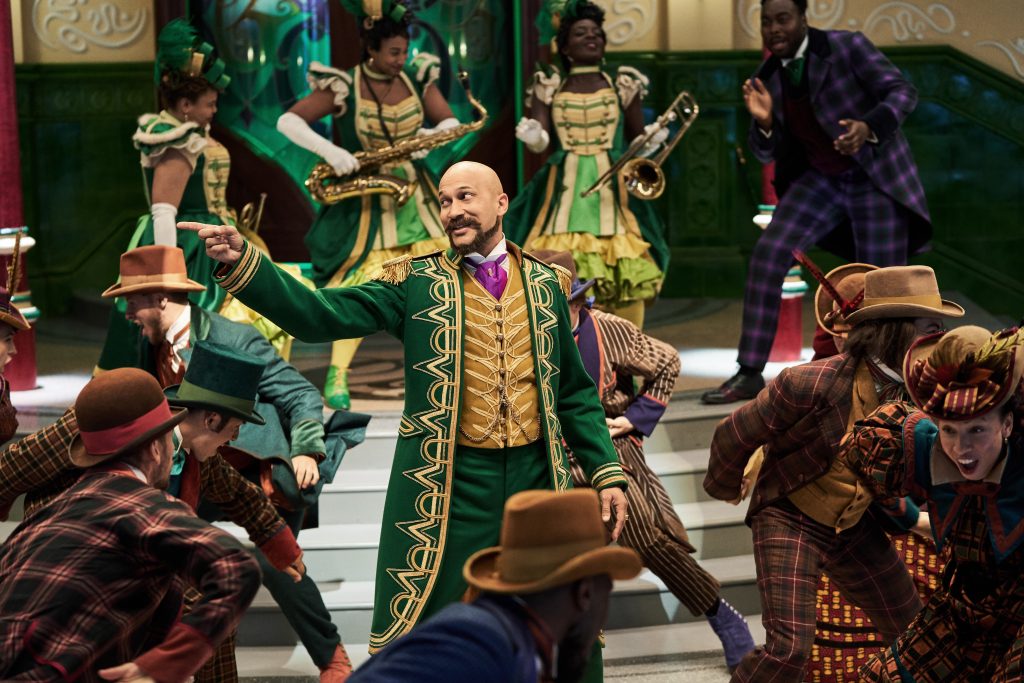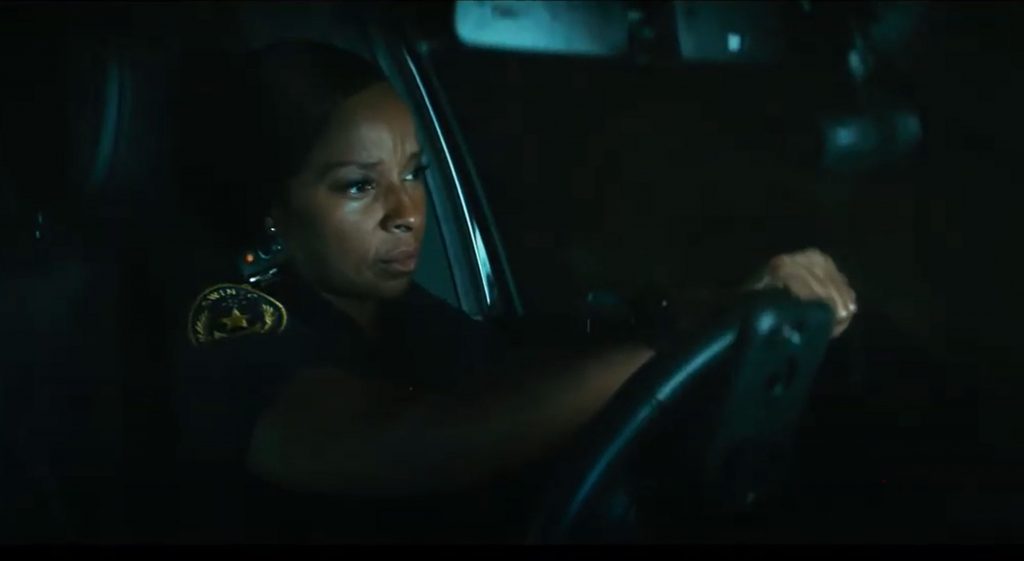December 31, 2020
by Carla Hay

“Jingle Jangle: A Christmas Journey”
Directed by David E. Talbert
Culture Representation: Set in an unnamed city during the 1860s to 1890s, the musical film “Jingle Jangle: A Christmas Journey” features a predominantly African American cast of characters (with some white people, Latinos and Asians) representing the working-class, middle-class and wealthy.
Culture Clash: After being betrayed by a former apprentice, an inventor-turned-pawnbroker has his cynicism and disillusionment challenged by his precocious and optimistic 10-year-old granddaughter.
Culture Audience: “Jingle Jangle: A Christmas Journey” will appeal primarily to people interested in family-friendly musicals that celebrate hope and resilience.

The movie musical “Jingle Jangle: Christmas Journey” conveys unabashed sentimentality in such an earnest, charming and entertaining way that its predictable story will be easier to take if people expect nothing more than what this movie is: an inoffensive Christmas-themed story that can appeal to various generations. “Jingle Jangle” has got a little something for everyone to enjoy, unless someone really hates musicals or mostly cheerful family entertainment. Written and directed by David E. Talbert, “Jingle Jangle” is a vibrant homage to old-school musicals while managing to have timeless, not outdated, qualities.
The acting, costume design, choreography, production design, visual effects and original music all elevate the story, which at times drags a little in its pace in the middle of the movie. There’s a flying robot named Buddy 3000 in the movie that looks like a combination of the two main robot characters in Pixar’s 2008 animated film “WALL-E.” The sci-fi aspect of “Jingle Jangle” seems recycled from much-better movies. But the rest of “Jingle Jangle” showcases more originality when it comes to the unique and believable chemistry of the cast members in this well-cast film.
The story is narrated by a grandmother (played by Phylicia Rashad), who is shown reading this tale to her two grandchildren (played by Ria Calvin and Kenyah Sandy) during the Christmas holiday season. “Jingle Jangle: A Christmas Journey” is essentially the saga of a family damaged by broken dreams and learning to heal from these emotional wounds. The clan at the center of the story is the Jangle Family, whose patriarch is a brilliant inventor named Jeronicus (played by Justin Cornwell as a young man and by Forest Whitaker as a senior citizen).
In his youth, Jeronicus had a charmed life, with a successful shop called Jangles & Things, where he and his family lived; a loving wife named Joanna (played by Sharon Rose); and a smart and friendly daughter named Jessica (played by Diaana Babnicova as a child and Anika Noni Rose as an adult), who aspired to follow in her father’s footsteps and become an inventor.
Jeronicus has an apprentice named Gustafson (played by Miles Burrow as a young man and by Keegan-Michael Key in middle-age), who idolizes Jeronicus. Gustafson wants to show Jeronicus a special invention he’s been working on, but Jeronicus keeps telling Gustfason that he’s too busy. One of Jeronicus’ inventions is a doll dressed like a matador named Don Juan Diego (voiced by Ricky Martin) that mysteriously comes to life. Don Juan Diego is flashy, flamboyant and loves to call attention to himself.
But this isn’t a harmless toy. Don Juan Diego is also a corrupt-minded doll that convinces Gustafson to steal Jeronicus’ book of invention ideas. (Don Juan Diego’s solo musical number is aptly called “Borrow Indefinitely.”) Gustafson commits this theft because he feels unappreciated as Jeronicus’ employee. And over time, Gustafson uses the ideas in the book to become the richest and most powerful inventor in the world.
After this betrayal, Jeronicus’ life takes a turn for the worse. His beloved wife Joanna dies. And Jeronicus’ fortunes begins to wane as Gustafson’s fortunes begin to rise. Jeronicus feels broken and defeated. And so, he sends his daughter Jessica away because she thinks that she’s better off not living with him. Jeronicus becomes very reclusive and vows never to invent anything again.
The story then fast-forwards to Jessica as a single mother to a bright and inquisitive 10-year-old daughter named Journey (played by Madalen Mills), who has inherited her mother’s love of science and interest in becoming an inventor. Jessica has not seen or spoke to her father for years. There are lingering hard feelings because Jessica believes that Jeronicus abandoned her.
However, Jessica doesn’t want Jeronicus to be deprived of knowing his granddaughter, so she sends Journey to visit Jeronicus as a surprise. When Journey arrives at the Jangles & Things shop, where Jeronicus still lives, she finds out that the shop no longer sells his inventions but instead is now a pawn shop. Jeronicus is a grumpy old man who at first doesn’t believe that Journey when she tells him that she’s his granddaughter.
However, he’s convinced that Journey is telling the truth after Journey tells Jeronicus many things about Jessica that only a close family member would know. Jeronicus reluctantly agrees to let Journey stay with him and makes her sign a contract where she agrees to do the cleaning and other chores. Jeronicus also forbids Journey to look at or touch any of his old inventions that are stored in an attic. But since Journey is a very curious child, you just know that she’ll break this rule.
Other supporting characters in the story include an orphan named Edison (played by Kieron L. Dyer), who befriends Journey; Mr. Delacroix (played by Hugh Bonneville), a banker whose friendship with Jeronicus helps Jeronicus get extensions on his unpaid loans; and Ms. Johnston (played by Lisa Davina Phillip), a postal service delivery person who is very attracted to Jeronicus and not shy about showing it, even though Jeronicus is often oblivious to her romantic interest in him.
Even though Gustafson is the chief villain in the movie, “Jingle Jangle” doesn’t get too dark or disturbing with his storyline. Key brings his talent as a comedian to his portrayal of Gustafson, by making this character more like a cartoonish fraudster who is his own worst enemy when it comes to his greed, rather than someone who’s a truly deranged and violent criminal. Gustfason’s big musical number “Magic Man G” is one of the highlights of the movie.
Another show-stopping number is “Make It Work,” a soaring anthem performed by Anika Noni Rose and Whitaker. Journey’s musical showpiece is “Square Root of Possible,” which perfectly demonstrates why Mills is multitalented performer to watch. “Jingle Jangle” features several original songs written by Philip Lawrence, Michael Diskint, Davy Nathan and John Stephens (better known as John Legend), who is one of the producers of the movie. The songs can best be described as a mixture of light R&B with traditional stylings of a stage musical.
The heart of the story and what that works the best in “Jingle Jangle” is the relationship between Jeronicus and is granddaughter Journey, because they both learn things from each other that help make them better people. There’s a part of “Jingle Jangle” that veers into a sci-fi adventure story, with the expected “race against time” chase scene. But “Jingle Jangle” is mostly a sweet-natured tale of how love can rekindle faith and can sustain families through the hardest times.
Netflix premiered “Jingle Jangle: A Christmas Journey” on November 13, 2020.


